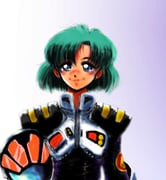Edit
The NEC PC Engine (PCエンジン Pī Shī Enjin), known in the west as the TurboGrafx-16 Entertainment SuperSystem, is a video game console joint-developed by Hudson Soft and NEC Corporation, released in Japan on October 30, 1987, and in the United States on August 19, 1989. It was the first console released in the 16-bit era, albeit still utilizing an 8-bit CPU. Originally intended to "beat" the Nintendo Famicom (which it achieved in Japan), it ended up competing against the likes of the Sega Mega Drive, Super Famicom, and even the Neo Geo AES.
The TurboGrafx-16 has an 8-bit CPU and a dual 16-bit GPU; and is capable of displaying 482 colors simultaneously, out of 512. With dimensions of 14 cm×14 cm×3.8 cm (5.5 in×5.5 in×1.5 in), the NEC PC Engine holds the record for the world's smallest game console ever made.
In the United Kingdom, Telegames released a slightly altered version of the American model simply as the TurboGrafx around 1990 in extremely limited quantities. Although there was no full-scale PAL region release of the system, imported PC Engine consoles were largely available in France and Benelux through major retailers thanks to the unlicensed importer Sodipeng (Société de Distribution de la PC Engine, a subsidiary of Guillemot International).
In Japan, the PC Engine was very successful. It gained strong third-party support and outsold the Famicom at its 1987 debut, eventually becoming the Super Famicom's main rival. However, the TurboGrafx-16 failed to break into the North American market and sold poorly, which has been blamed on the delayed release and inferior marketing.
At least 17 distinct models of the console were made, including portable versions and those that integrated the CD-ROM add-on. An enhanced model, the PC Engine SuperGrafx, was rushed to market in 1989. It featured many performance enhancements and was intended to supersede the standard PC Engine. It failed to catch on—only six titles were released that took advantage of the added power and it was quickly discontinued. The final model was discontinued in 1994.
Two major revisions, the PC Engine SuperGrafx and the PC Engine Duo, were released in 1989 and 1991, respectively. The entire series was succeed by the unsuccessful PC-FX in 1994, which was only released in Japan after the TurboGrafx-16 and its revised variants failed to gain enough market share in North America.
Note that this tag is for a game console. For a personal computer (PC), use computer instead.
See also
The following tags are aliased to this tag: turbografx-16 (learn more).

